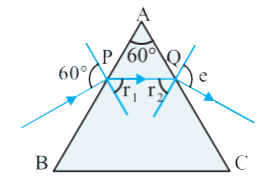A ray of light is incident at an angle of 60∘ on one face of a prism of angle 30∘. The ray emerging out of the prism makes an angle of 30∘ with the incident ray. The emergent ray is
0∘
45∘
90∘
30∘
The correct Answer is:D
To solve the problem, we need to determine the angle of the emergent ray as it exits the prism. Here's a step-by-step solution:
Step 1: Understand the given information
We are given:
- Angle of incidence (i) = 60°
- Angle of the prism (A) = 30°
- Angle between the incident ray and the emergent ray (Δ) = 30°
Step 2: Use the formula for the angle of deviation
The angle of deviation (Δ) for a prism can be expressed using the formula:
Δ=i+e−A
where:
- i = angle of incidence
- e = angle of emergence
- A = angle of the prism
Step 3: Substitute the known values into the formula
Substituting the known values into the formula:
30°=60°+e−30°
Step 4: Simplify the equation
Now, simplify the equation:
30°=60°+e−30°
30°=30°+e
Step 5: Solve for the angle of emergence (e)
To isolate e, we can subtract 30° from both sides:
30°−30°=e
0°=e
Conclusion
The angle of emergence e is 0°. This means that the emergent ray is parallel to the base of the prism.
Final Answer
The emergent ray is at an angle of 0° with respect to the normal at the exit face of the prism.
---
We are given:
- Angle of incidence (i) = 60°
- Angle of the prism (A) = 30°
- Angle between the incident ray and the emergent ray (Δ) = 30°
The angle of deviation (Δ) for a prism can be expressed using the formula:
Δ=i+e−A
where:
- i = angle of incidence
- e = angle of emergence
- A = angle of the prism
Substituting the known values into the formula:
30°=60°+e−30°
Now, simplify the equation:
30°=60°+e−30°
30°=30°+e
To isolate e, we can subtract 30° from both sides:
30°−30°=e
0°=e
The angle of emergence e is 0°. This means that the emergent ray is parallel to the base of the prism.
The emergent ray is at an angle of 0° with respect to the normal at the exit face of the prism.
Topper's Solved these Questions
Similar Questions
A ray of light is incident at an angle of 60∘ on one face of a prism which has refracting angle of 30∘ . The ray emerging out of the prism makes an angle of 30∘ with the incident ray. If the refractive index of the material of the prism is μ=√a , find the value of a .
View SolutionA ray of light is incident at an angle of 60∘ on the face of a prism having refracting angle 30∘. The ray emerging out of the prism makes an angle 30∘ with the incident ray. Show that the emergent ray is perpendicular to the face through which it emerges.
View Solution
Knowledge Check
A ray of light is incident at 60∘ on one face of a prism of angle 30∘ and the emergent ray makes 30∘ with the incident ray. The refractive index of the prism is
A1.732B1.414C1.5D1.33
A ray of light is incident at an angle of 60∘ on the face of a prism having refracting angle 30∘. The ray emerging out of the prism makes an angle 30∘ with the incident ray. Show that the emergent ray is perpendicular to the face through which it emerges.
View SolutionA ray of light is incident at an angle of 60∘ on the face of a prism having refracting angle 30∘. The ray emerging out of the prism makes an angle 30∘ with the incident ray. Show that the emergent ray is perpendicular to the face through which it emerges and calculate the refractive index of the material of prism.
View SolutionA ray of light is incident at an angle of 60∘ on the face of a prism having refracting angle 30∘. The ray emerging out of the prism makes an angle 30∘ with the incident ray. Show that the emergent ray is perpendicular to the face through which it emerges and calculate the refractive index of the material of prism.
View SolutionA ray of light is incident at 60∘ on one face of a prism of angle 30∘ and the emergent ray makes 30∘ with the incident ray. The refractive index of the prism is
View SolutionA ray of light is incident at 65∘ on one face of a prism of angle of 30∘ and the emergent ray makes 35∘ with the incident ray. The refractive index of the prism is:
View SolutionA Ray of light is incident at an angle 60° on one face of a prism which has protecting angle of 30°. The emerging ray deviates through 30° from incident light. The refractive index of material of prism is
View SolutionA ray of light is incident on one face of a prism (m=√3) at an angle of 60∘. The refracting angle of the prism is also 60∘. Find the angle of emergence .

View Solution
